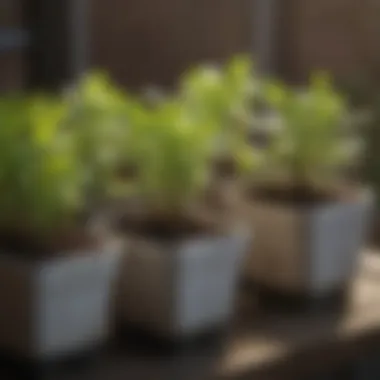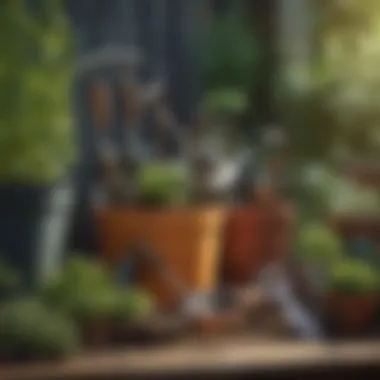Growing Vegetables in Pots: A Practical Guide


Intro
Growing vegetables in pots presents a practical solution for many urban dwellers and gardening enthusiasts. As the world shifts toward sustainable living, container gardening becomes increasingly relevant. It offers an avenue to cultivate fresh produce even in the most limited spaces. This guide aims to highlight the benefits of pot gardening, focusing on key points such as plant selection, nurturing methods, and space management.
Growing vegetables in containers allows individuals to overcome various challenges associated with restricted spaces. Regardless of your available area, you can create a productive garden by utilizing balconies, patios, or even window sills. The benefits are numerous. From using high-quality soil to managing sunlight exposure, every factor plays a significant role in the success of your container garden. Additionally, some specific plants thrive exceptionally in pots, making it easier to enjoy a diverse harvest.
This article will explore different vegetables suitable for container gardening, practical tips for cultivation, and the environmental considerations necessary for achieving a fruitful garden. With the right understanding and approach, anyone can take part in this fulfilling endeavor and enjoy the many advantages it brings.
Prelude to Container Gardening
Container gardening has gained significant traction among green thumbs and urban dwellers alike. The practice allows individuals to cultivate various plants where traditional garden space may be lacking. This section establishes the importance of container gardening as a first step toward understanding how to grow vegetables in pots effectively.
Container gardening offers a myriad of benefits that appeal to a wide range of individuals. Notably, it assists those with limited outdoor space, providing an opportunity to enjoy the pleasures of gardening without extensive land. Moreover, it enables gardeners to control their environment closely, ensuring a suitable setting for the plants' growth.
Another aspect to consider is that container gardening is largely cohesive with the trend of sustainable living. As people grow more conscious of their environmental footprint, pot gardening represents a practical choice that not only reduces the need for large land but also promotes home-grown produce.
Definition and Benefits
Space efficiency
Space efficiency is a significant aspect of container gardening. It allows individuals to use limited areas creatively. In urban settings, where yards may be small or nonexistent, growing vegetables in pots can turn balconies or even window sills into productive gardens. This adaptability makes container gardening a popular choice for city residents who seek fresh produce without compromising on space.
The unique feature of space efficiency is its flexibility in design. With various sizes and shapes of pots available, gardeners can maximize their available space, placing containers in optimal positions for sunlight and accessibility. However, the trade-off can be a limitation on the number of plants one can grow at once, necessitating careful planning and selection of varieties.
Accessibility and mobility
Accessibility and mobility are crucial elements of container gardening. Containers offer ease in moving plants according to season, light availability, or aesthetic preferences. This feature is especially beneficial for individuals with mobility issues or physical limitations, as it allows them to tend to gardens at their convenience without the need to navigate tricky terrain.
By being mobile, plants are also better protected from harsh weather conditions or unforeseen pests. Nonetheless, while mobility provides significant advantages, it may also require consistent attention to watering and care, as plants will be less reliant on stable conditions compared to those growing in fixed garden beds.
Control over soil quality
Control over soil quality is another compelling reason for embracing container gardening. Gardeners can select the best soil mix suited to the specific needs of their chosen vegetables. Unlike traditional gardening, where soil quality can vary greatly and may require amending, pots allow for exact mixtures tailored to individual plants. This precise control can lead to healthier, more productive yields.
The variety in soil choices—from organic potting mixes to homemade blends—can enhance growth and ensure that nutrients reach the plants efficiently. However, it is essential to note that keeping soil quality consistent demands ongoing investment in fertilizers and amendments. This maintenance is crucial for achieving the desired results in a container garden.
Ideal Environments for Pot Gardening
Balconies
Balconies serve as an ideal environment for pot gardening, especially in urban settings. They often provide sunlight exposure and wind protection, creating an excellent microclimate for various vegetable plants. Moreover, balconies offer sufficient height, enabling gardeners to explore vertical options and save even more ground space.
The distinct advantage of balcony gardening is the feeling of being surrounded by nature while still being in a bustling city. However, gardeners must consider potential space limitations, as well as the weight of the containers, especially in high-rise buildings, where structural integrity may be a concern.
Patios
Patios are another prominent environment for growing vegetables in pots. These spaces allow for strategic planting based on sunlight and shade patterns throughout the day. Furthermore, patios typically have easy access to water sources, simplifying the maintenance aspect of gardening.
With greater room to work with, a patio can accommodate a wide range of pot sizes and a diverse array of plants. However, it is important for gardeners to consider the potential for pests and irritants, such as debris from nearby trees or structures, which may impact plant health.
Indoor spaces
Indoor spaces have increasingly become popular for growing vegetables in pots. Growing indoors allows for completely controlled conditions. It also shifts the focus toward year-round gardening, independent of the external weather conditions.
The beauty of indoor gardening lies in the opportunity to create diverse environments using grow lights and temperature regulation tools. However, there may be more stringent conditions to monitor, such as humidity levels and ventilation, which can prove challenging for novice gardeners.
"Container gardening enables urban individuals to reconnect with nature and manage a sustainable lifestyle, regardless of their limited outdoor space."
This comprehensive understanding of container gardening sheds light on various opportunities and considerations. The diverse environments, combined with benefits such as space efficiency and controlled soil quality, bolster the practicality of growing vegetables in pots, paving the way for more detailed exploration in subsequent sections.
Choosing the Right Pots
Choosing the right pots is a crucial aspect of successful container gardening. The type of container can significantly influence plant health, growth, and the overall yield of vegetables in pots. Selecting appropriate materials and sizes is essential, as it affects drainage, soil temperature, and root development. This section explores various pot materials and size considerations, ensuring that gardeners can make informed choices for optimal vegetable production in limited spaces.
Materials for Containers
Plastic
Plastic pots are among the most common choices for container gardening. They are lightweight and often less expensive compared to other materials. Happy plants can thrive in these pots because they retain moisture well, benefiting root growth. However, one must consider that plastic pots may heat up quickly in direct sunlight, which can lead to root stress during hotter months. Additionally, certain types of plastic may not allow for adequate drainage unless the bottom is designed with holes.
Terracotta
Terracotta pots have a natural, earthy appearance that many gardeners appreciate. They are made from clay and offer excellent breathability. This allows moisture to evaporate from the sides, which can prevent overwatering. However, this characteristic can also lead to more frequent watering needs, especially in warmer climates. Terracotta is a good choice for those looking for aesthetics and functionality in their gardening efforts, but gardeners should be ready to adjust their watering routines accordingly.
Metal
Metal containers, such as galvanized steel or aluminum, are durable and resistant to decay. They can be visually striking in a garden setup. A key characteristic of metal pots is their ability to retain heat, which can be beneficial for plants requiring warmth. However, this can also pose a risk of overheating roots if placed in constant direct sunlight. Moreover, metal should have proper drainage to avoid pooling water that can harm root systems.
Wood
Wooden planters provide a traditional look that fits well with many outdoor settings. They can be highly customizable in shape and size. Wood tends to insulate roots effectively, protecting them from extreme temperatures. However, it is crucial to select untreated wood that can withstand moisture without rotting, or to use liners to protect the interior. Wooden pots may require more maintenance and care compared to other materials, yet they effectively create a nice aesthetic touch to any container garden.


Size and Shape Considerations
Depth for root growth
The depth of a pot is vital for successful root growth. Shallow pots can restrict root development, while deeper pots offer more space for roots to anchor and access nutrients. Most vegetables thrive in a minimum depth of 12 inches; however, deeper pots are often better for root vegetables. A deeper container ensures that roots can spread out and absorb water and nutrients efficiently.
Width for plant spacing
Width is another key consideration when selecting pots. Wider pots allow for better plant spacing, which results in healthier plants with fewer diseases. Proper spacing helps in air circulation, preventing fungal infections and improving overall plant health. Choosing pots that provide adequate space based on the type of vegetables being grown can directly correlate with the success rate of the container garden.
Shape to optimize space
The shape of the pot can also impact how space is utilized in container gardening. Round pots are common, but square or rectangular containers can fit more snugly in small areas. Using various shapes can allow gardeners to maximize their planting area. In urban settings, where space is often limited, selecting pots that can be stacked or arranged strategically can lead to more productive growing areas.
Selecting Vegetables for Container Growth
Selecting the right vegetables for container gardening is a fundamental aspect of achieving a bountiful harvest. The emphasis on this topic stems from the understanding that not all vegetables thrive in a limited space. Container gardening poses unique challenges and opportunities that require careful consideration of vegetable types. Some plants are more adaptable to pot conditions, while others may struggle. The right choices not only ensure productive growth but also enhance the gardening experience.
Leafy Greens
Lettuce varieties
Lettuce ranks among the most versatile vegetables for container gardening. Its quick growth cycle and adaptability to various climates make it an excellent choice for beginners. Lettuce varieties include romaine, butterhead, and leaf lettuce, which can flourish within smaller pots. One significant feature of lettuce is its ability to be harvested multiple times. By cutting only the outer leaves, the plant continues to develop. This characteristic allows for ongoing yield from a single planting, maximizing space efficiency and providing fresh greens for an extended period.
Spinach
Spinach is another superb option for container gardens. This leafy green is quite nutritious and can be planted in early spring or fall, allowing for multiple growing seasons. One key characteristic is its ability to grow well in partial shade. This makes spinach ideal for urban gardens, where sunlight may be limited. However, spinach has a relatively short harvest window. Timely planting and monitoring are crucial for preventing bolting, which can affect taste. Its rich flavor and leafy texture contribute significantly to salads and other dishes.
Kale
Kale has gained popularity as a nutrient powerhouse in recent years. This leafy green is not only robust but also offers diverse varieties, such as curly and Tuscan kale. Kale is especially beneficial for container growing due to its tolerance for cooler temperatures. A unique feature of kale is its continuous production; as older leaves are picked, new ones sprout in their place. However, gardeners should be mindful of pests like aphids, which may favor kale plants. Proper management ensures that the benefits of growing kale can be fully realized without significant interruptions in growth.
Root Vegetables
Carrots
Carrots are a rewarding choice for pot gardening. They grow primarily underground, making them well-suited to containers with adequate depth. A key characteristic of carrots is their versatility in flavor and variety; ranging from sweet to earthy tones. When cultivating carrots, a loose potting mix is essential to permit optimal root growth. The unique feature of carrots is their ability to thrive with consistent moisture. Without proper watering, they may become woody or misshapen. Growing carrots in pots allows for easier monitoring of water levels.
Radishes
Radishes are often considered a must-have for any container garden. Their rapid growth cycle allows for quick returns on planting, typically within three to four weeks. A primary element that makes radishes appealing is the variety available, from classic red to unique black radishes. Additionally, radishes can be sown successively for staggered harvesting. Although they are compact and easy to grow, proper spacing is necessary to prevent overcrowding. This ensures healthier roots develop in each piece, benefiting the overall harvest quality.
Beets
Beets are also a worthy addition to container gardening. They are generally straightforward to grow and provide substantial nutritional benefits. The unique feature of beets is their dual functionality; both the leafy tops and the taproot are edible, offering diverse culinary uses. In a container, beets require at least twelve inches of depth to develop properly. While beets are tolerant of varying conditions, adequate sunlight remains critical for optimal growth. Container gardening simplifies care, allowing you to tailor the growing environment.
Fruiting Vegetables
Tomatoes
Tomatoes are perhaps the most favored fruiting vegetable for home gardeners. They thrive in pots, especially determinate varieties. A key characteristic is their need for ample sunlight and warm temperatures. Tomatoes reward patience with a bountiful yield, making them worthwhile. However, they may require staking or caging for support, especially as the plants mature. One disadvantage is their vulnerability to diseases, necessitating careful observation. Effective care can lead to vibrant, home-grown tomatoes.
Peppers
Peppers share similar cultivation needs with tomatoes, making them suitable for container gardening. The unique feature of bell peppers and hot peppers is their compact growth habit, allowing them to flourise in smaller pots. A notable advantage is their resilience in varying conditions, displaying a range of colors at maturity. Regular watering and fertilization are key factors in producing healthy fruits. However, peppers may require a long growing season to achieve full flavor, underscoring the importance of early planting.
Eggplants
Eggplants also excel in container settings. They are known for their glossy exterior and broad use in recipes. The unique aspect of eggplants is their sensitivity to cold and their preference for warm conditions. Choosing smaller varieties, such as Japanese eggplant, maximizes success in pots, where space and heat might be limited. However, proper care is necessary in managing pests, particularly aphids. Keeping a close watch ensures a successful crop.
Herbs as Companion Plants
Basil
Basil is an essential herb for container gardens, often utilized as a companion plant. Its key characteristic is its fragrant leaves, which many find appealing for culinary uses. Moreover, basil grows well alongside tomatoes, enhancing flavor and deterring certain pests. Its ease of growth makes it a beneficial choice for novice gardeners. However, basil does require consistent watering and well-drained soil to thrive. This vigilance pays off with continuous fresh herbs ready for harvesting.
Parsley
Parsley is a hardy herb that thrives in pots. It is easily grown from seeds and can be sown in cool weather. The unique feature of parsley is its ability to act as a companion plant, benefiting other crops by attracting beneficial insects. Its versatility in the kitchen adds to its appeal. A potential challenge is its slower growth compared to other herbs, which may require some patience from gardeners. Nevertheless, its culinary value is substantial, making it a popular choice.
Cilantro
Cilantro is another herb that flourishes in container gardens. Known for its distinct flavor, cilantro grows quickly and can be harvested several times in a season. A key aspect of cilantro is its preference for cooler temperatures, which differentiates it from many other herbs. This unique feature means that timing is essential in managing its growth. Expedited planting can lead to an abundant harvest, providing fresh garnish for various dishes. Yet, cilantro tends to bolt quickly in hot weather, which could limit its growing season.
Soil and Fertilization Practices
Soil quality and fertilization are crucial components in container gardening. An appropriate mix ensures that plants receive the nutrients they need while allowing water to drain properly. Without quality soil, even the best vegetable varieties can struggle to thrive. Below, we explore how to select the right potting mix and fertilization techniques to enhance plant growth.
Choosing the Right Potting Mix
Selecting the right potting mix can have a significant impact on the health of your plants. A good mix provides nutrients, retains moisture, and allows excess water to escape.
Commercial potting soil


Commercial potting soils are widely available and specifically formulated for container gardening. These soils usually contain a balanced mix of organic material, such as peat, and additives to enhance drainage and aeration. One key characteristic of commercial potting soil is its consistency, which can support various plant types.
The advantage lies in its convenience; it requires no preparation and is easy to find in local gardening stores or online. However, some commercial mixes might contain synthetic additives or fertilizers that may not align with all gardeners’ preferences.
Homemade mixes
Creating your own potting mix allows for full control over what goes into your garden. Homemade mixes can combine various materials, such as compost, coconut coir, and perlite. This customization leads to a tailored growth environment for specific plants. The key feature here is flexibility; you can adjust the ingredients based on your specific needs. However, preparing your own mix demands time and knowledge. It might not always provide the same consistency as commercial options.
Importance of drainage
Drainage is vital in container gardening because it helps prevent root rot caused by excess water. A potting mix with good drainage allows the plant roots to breathe and mitigates waterlogging. This feature is essential for vegetables, which often thrive in well-drained soils.
Offering excellent drainage can also improve nutrient uptake since air can reach plant roots more easily. Neglecting drainage can lead to unhealthy plants, which hinders your gardening efforts.
Fertilization Techniques
Fertilization is an essential part of caring for your container vegetables. Proper feeding supports growth and fruiting. Different methods and frequencies can lead to better crop yields and healthier plants.
Organic versus synthetic fertilizers
Organic fertilizers are derived from natural sources like compost and manure. They enrich the soil over time, providing a slow release of nutrients. One important aspect of organic fertilizers is their ability to improve soil health long-term, which is beneficial in maintaining an eco-friendly garden.
Conversely, synthetic fertilizers offer immediate nutrient availability, making them popular for quick fixes. However, they can lead to nutrient imbalances if not used properly. Choosing between the two depends on your gardening philosophy and goals.
Application frequency
How often you fertilize your plants can dictate their growth patterns. Different vegetables have varying needs, and understanding these will help optimize their development. Regular applications can promote consistent growth, but over-fertilization may stress plants or damage roots.
Consider the specific requirements of the vegetables you grow and apply nutrients accordingly. Monitoring the plants’ health will give you cues on maintaining the right frequency.
Liquid versus granular forms
Liquid fertilizers dissolve quickly in water, allowing for rapid absorption. This form can be especially helpful for container gardening, where immediate results are often desired.
Granular fertilizers release their nutrients slowly, leading to extended periods of nourishment. Although the onset may be slower than liquid forms, this method can enhance overall plant vigor over time. Deciding which form to use should align with your gardening goals and how quickly you aim to see results.
The choice of potting mix and fertilization techniques can significantly affect the success of growing vegetables in containers. A thoughtful approach yields better results.
Watering Techniques for Pot Grown Plants
Watering is a critical aspect of container gardening. Understanding how and when to water your plants can significantly affect their health and growth. Unlike traditional gardens, pots have limited soil volume, which influences how moisture is retained. Excessive or inadequate watering can lead to detrimental outcomes for your vegetables. Therefore, having effective techniques to manage watering will enhance your gardening success.
Watering Frequency
Factors influencing frequency
The frequency of watering is primarily determined by several factors such as plant type, climate, and pot size. For example, leafy greens generally require more moisture than root vegetables. Warmer weather will also necessitate more frequent watering due to quicker evaporation rates. Pot size impacts how often you need to water; smaller pots may dry out faster than larger ones. By observing these factors, you can ensure the right watering schedule for your plants.
Signs of overwatering
Detecting overwatering is vital for maintaining healthy plants. Common signs include yellowing leaves, wilted appearance, and root rot. This is a critical consideration because it leads to fungal diseases and can kill your plants over time. Monitoring drainage in your pots is important. Good drainage practices can reduce these risks.
Signs of underwatering
Underwatering can also be problematic. Signs to look for include dry soil, crispy leaves, and plants that may droop. If identified early, underwatering can be corrected easily. However, prolonged neglect can hinder growth significantly. A consistent monitoring routine is beneficial for preventing this issue.
Effective Watering Methods
Choosing the right method for watering contributes to plant health. Here are a few effective methods:
Drip irrigation systems
Drip irrigation systems offer a controlled way to water plants slowly at the root level. This technique is beneficial as it conserves water while reducing fungal diseases associated with top watering. It is particularly useful in urban gardening setups, where efficiency is paramount. While it requires a bit more setup, the results often justify the investment.
Hand watering techniques
Hand watering techniques remain one of the most common methods. This approach allows for precise control over how much water each plant receives. However, it can be labor-intensive. A watering can or hose with a spray nozzle can be used for this purpose. Being involved in your garden can also enhance your understanding of your plants' needs.
Using self-watering pots
Self-watering pots simplify the watering process. These containers often have a reservoir that provides a steady supply of moisture to the soil. They are especially advantageous for busy gardeners. The unique feature here is that they mitigate the risk of both underwatering and overwatering effectively. However, it is crucial to still monitor moisture levels to avoid reliance on these systems alone.
Proper watering techniques can greatly influence the success of your vegetable garden in pots. Regular monitoring and adapting your approach based on the signals your plants give will lead to a more flourishing vegetable patch.
Pest Management in Container Gardening
Effective pest management is critical for successful container gardening. When growing vegetables in pots, the confined space and concentrated soil can make plants more vulnerable to pests and diseases. Therefore, understanding how to identify and manage these issues is essential for the health of your plants and for achieving a productive harvest. Pest management not only protects the plants but also enhances the overall gardening experience by reducing stress and frustration.
Common Pests and Diseases
Aphids
Aphids are small, sap-sucking insects that can infest a wide range of plants. They usually congregate in colonies on the undersides of leaves, where they feed on plant sap. Their presence can indicate larger issues, such as overall plant health. Aphids reproduce quickly, making them a common sight in container gardens. The key characteristic of aphids is their ability to reproduce asexually, leading to rapid population growth.
One unique feature of aphids is their ability to produce a sticky substance known as honeydew, which can foster the growth of sooty mold, harming the appearance of plants. Managing aphids often involves introducing beneficial insects, like ladybugs, which are natural predators, or using insecticidal soap to control their population. However, it is critical to ensure these methods do not disrupt the ecosystem of the container garden.
Whiteflies
Whiteflies, much like aphids, are also sap-sucking pests that can harm plants by draining their energy. These small, white, winged insects are typically found on the underside of leaves. They can significantly impact growth rates and yield of vegetables in pots. Whiteflies are often more prevalent in warm environments, making them a concern for container gardening.
A defining feature of whiteflies is their ability to quickly reproduce, leading to potential infestations.f There are various methods to manage this pest, including yellow sticky traps and insecticidal soap. It is important to regularly check plants because their damage can sometimes mimic nutrient deficiencies, making early detection crucial.


Mildew and Rot
Mildew and rot are two significant diseases that can affect container-grown vegetables. Mildew appears as a white coating on leaves and can lead to stunted plant growth. It thrives in conditions of high humidity and poor air circulation. Both fungal infections cause considerable harm as they block sunlight and produce toxins that stress the plant.
The benefit of understanding these diseases is the proactive approach you can take to mitigate risks. Maintaining proper watering techniques, ensuring adequate spacing between plants, and selecting disease-resistant varieties can help prevent these issues. However, once mildew or rot appears, treatment might involve removing affected plant parts and using fungicides, which should be applied with care to avoid harming beneficial organisms.
Preventive Measures and Treatments
Companion Planting Strategies
Companion planting is a method that involves growing different plants together to enhance growth, repel pests, or increase productivity. Certain plants can deter pests, making this strategy attractive for container gardening. The key characteristic of companion planting is that it focuses on the relationships between different plant species, which can provide natural pest control and promote healthier plants.
One unique feature of companion planting is its dual functionality; it can increase yields and create a more diverse ecosystem within your container garden. For example, planting marigolds alongside vegetables can help repel aphids and whiteflies. However, careful planning is necessary, as not all plant combinations are beneficial.
Natural Pesticides
Natural pesticides offer a safer alternative to chemical options, maintaining the health of the garden ecosystem. These products, derived from natural sources, can be effective against a variety of pests. The benefit of using natural pesticides is minimizing negative impact on beneficial insects and the environment.
Natural pesticides, such as neem oil or insecticidal soap, are useful for treating infestations without introducing harmful chemicals. One advantage is that they typically break down and do not persist in the environment, reducing the overall negative impact. However, they may need to be reapplied more frequently than synthetic options, making regular monitoring essential to ensure their effectiveness.
Regular Plant Inspections
Conducting regular inspections of your container garden is one of the most effective ways to prevent pest problems. This practice allows you to identify issues before they escalate, ensuring your plants remain healthy. The key characteristic of regular inspections is their proactive nature, which aims to catch pests and diseases early.
One unique feature of this practice is the educational aspect; as you inspect your plants, you become more familiar with their growth patterns and potential issues. This knowledge enables you to respond quickly to problems, whether that might involve adjusting care routines or treating infestations. While this process requires commitment, the long-term benefits exceed the time investment.
Harvesting Techniques for Container Vegetables
Harvesting is a crucial phase in container gardening. It is the culmination of all efforts put into growing vegetables. Proper techniques enhance the quality and flavor of the produce. Knowing when and how to harvest can make a significant difference. Timing and methods impact yield and plant health. This section delves into essential aspects of harvesting vegetables grown in pots.
When to Harvest
Signs of readiness
Understanding the signs of readiness is essential for a fruitful harvest. Different vegetables exhibit unique indicators. For example, tomatoes shift from green to bright red when ripe. Similarly, leafy greens often signal readiness by reaching full size. These visual cues are vital. When harvested at the right time, vegetables achieve their best flavor and texture.
It's crucial to observe the vegetable's growth pattern. Healthy plants show vibrant colors and firm textures.
Moreover, under harvesting can lead to missed opportunities. Waiting too long might affect taste and tenderness. Therefore, vigilant monitoring is beneficial.
Timeframes for different vegetables
Each vegetable has its distinct growth timeframe from planting to harvest. For instance, radishes mature in about 30 days while peppers can take up to 80 days. Keeping a record of planting dates aids in planning. A calendar specifically for your garden may help track these periods.
In this context, early harvesting might enhance crop rotation opportunities. However, it is important not to pull a plant too soon. Insufficient development can reduce flavor and yield. Understanding the anticipated timeframes leads to better gardening practices.
Impact of weather on harvesting
Weather significantly influences the timing of the harvest. Warm, sunny days usually accelerate plant growth. Conversely, excessive rain or cold spells can delay maturity. Each vegetable reacts differently to weather variations. Knowing these influences allows for strategic harvesting decisions.
Additionally, extreme weather impacts the quality of the harvest. For example, harvesting lettuce during a heat wave can make it wilt quickly. Planning your harvest around weather patterns leads to more satisfying results.
Methods for Harvesting
Cutting versus pulling
Two methods of harvesting exist: cutting and pulling. The method chosen can depend on the type of vegetable. Cutting is often better for leafy greens and herbs. This technique preserves the root system and allows for regrowth. On the other hand, pulling works well for root vegetables like carrots or radishes.
Using the correct method guarantees quality. For example, cutting minimizes bruising which can harm the plant.
Tools required
Having the right tools is essential for effective harvesting. Common tools include scissors, pruners, and a trowel. Each tool serves a specific purpose. Scissors are suitable for herbs, while pruners handle thicker stems. Ensuring these tools are clean promotes good hygiene practices.
Additionally, using appropriate tools minimizes physical strain and enhances efficiency. Investing in good-quality tools may benefit long-term gardening initiatives.
Post-harvest handling
Post-harvest handling involves techniques that ensure the freshness of the produce. After harvesting, vegetables require proper cleaning. Excess soil should be removed, but without damaging the plant.
Storing harvested vegetables in a cool, dry place extends their shelf life. For delicate items like herbs, refrigerating can help maintain freshness.
Understanding these practices can prevent spoilage and enhance flavors. Overall, the techniques applied post-harvest are as important as the harvesting methods themselves.
End: The Future of Container Gardening
Container gardening is evolving as a significant method of urban agriculture. As cities expand and green space disappears, growing vegetables in pots presents an effective alternative. This approach not only allows for self-sufficiency but also addresses broader environmental issues. The future of container gardening will focus on sustainability, innovation, and community involvement, making it a crucial topic for modern gardening enthusiasts.
Sustainability in Urban Gardening
Reducing carbon footprint
Reducing the carbon footprint is more important than ever. By growing food at homes, individuals can save on transportation emissions linked to store-bought produce. Furthermore, one can minimize the carbon output associated with conventional farming practices. Container gardening promotes local food sources. This method reduces reliance on fossil fuels for transportation. It's sustainable and environmentally friendly.
Encouraging biodiversity
Encouraging biodiversity is vital in maintaining ecological balance. Container gardening can support various species by providing habitats for beneficial insects and promoting healthier ecosystems. The unique feature of this practice lies in its accessibility. It can inspire urban dwellers to cultivate different plant species, contributing to diverse urban habitats. This variety can have long-term benefits for local environments as it enhances pollination and encourages soil health, making it a popular choice among eco-conscious gardeners.
Resourceful practices for city dwellers
Resourceful practices are essential for making the most out of limited space. City dwellers often deal with constraints such as small balconies or little outdoor space. Container gardening offers solutions through limited setups like vertical gardens or multi-tiered planters. These techniques maximize available space while providing opportunities for food production. A unique feature of resourcefulness in container gardening is its adaptability. It allows individuals to grow even in the smallest of spaces, which is greatly beneficial, especially for those seeking homegrown vegetables.
Embracing Innovation
Vertical gardening systems
Vertical gardening systems have transformed the container gardening landscape. By utilizing vertical space, gardeners can cultivate multiple crops in tiny footprints. This approach is especially beneficial for those in urban settings where horizontal space is limited. Vertical systems also offer efficient water use, making them an eco-friendly choice. They are visually appealing and can act as a natural privacy screen or decorative element.
Smart gardening technology
Smart gardening technology provides an innovative way to approach container gardening. With devices like soil sensors and automated watering systems, gardeners can optimize their efforts. These tools remove the guesswork from watering and fertilization while ensuring plants receive what they need. This advancement can be particularly helpful for busy individuals who desire a thriving garden without constantly monitoring their plants. Utilizing this technology not only promotes sustainable practices, but also increases productivity in container gardening.
Community gardening initiatives
Community gardening initiatives have shown the collective power of container gardening. These programs bring together individuals with shared interests, fostering collaboration and learning. They create spaces for growing food, sharing knowledge, and building relationships among neighbors. A significant aspect of these initiatives is their capacity to enhance food security in communities. They empower individuals by promoting self-sufficiency while creating a sense of belonging. The unique feature here is the emphasis on community engagement, which is increasingly recognized as a beneficial approach to urban gardening.















